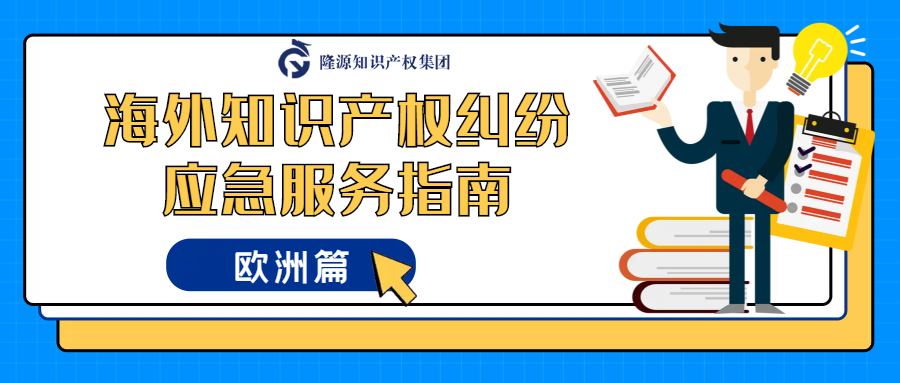As more and more Chinese enterprises "go out" to participate in
international competition and cooperation, cross-border protection of
intellectual property rights has become a compulsory course for innovative
enterprises to explore the international market. In order to help enterprises
and the general public with overseas intellectual property related needs,
Longyuan Intellectual Property Overseas Intellectual Property Service Platform
will continuously push overseas national intellectual property disputes
emergency services and risk prevention and control service guidelines.

This issue mainly pushes the first article - European Intellectual Property
Dispute Emergency Service and Risk Prevention and Control Service Guide. The
content is comprehensive and practical. Don't forget to collect and follow↓
1. European Intellectual Property Laws and Regulations and Relevant
Institutions
European Patent Office
The European Patent Organization was established in the 1970s, and its
subordinate European Patent Office (EPO) is a patent examining body established
under the European Patent Treaty.
The applicant submits a patent application to the European Patent Office,
and the participating countries recognize the patent examination process of the
European Patent Office. However, after the EPO has passed the examination, if
you want to enter a certain country, you need to submit a translation in its
official language to the country and publish it by the country's patent
management agency in order to obtain the country's patent protection, and the
subsequent maintenance fee to be paid to the country. If you want to protect in
multiple countries, you need to enter multiple countries and pay a lot of
fees.
In the past 10 years, Europe has been promoting the single patent system,
that is, an application can have patent rights in the entire EU after
authorization, and the rights do not need to enter a specific country. If this
scheme is implemented, it will greatly expand the scope of patent protection and
reduce the patent application and maintenance fees.
European Union Intellectual Property Office
For trademarks and designs, the European Union Intellectual Property Office
(EUIPO) is the competent authority responsible for the application and
protection of trademarks and designs.
Judicial
In terms of judiciary, patent cases in Europe are still being litigated in
each member state.
At the end of 2012, the EU passed the consent letter on the European
Unified Patent Court, but it has not yet started operation. Courts of first
instance include central courts, local courts and district courts. The Central
Court is headquartered in Paris and will have two chambers in London and Munich.
Local and regional courts are located in EU member states. The Court of Appeal
is located in Luxembourg.
The Unified Patent Court is only responsible for patent cases involving
European patents and European unified patents, such as infringement and
invalidation lawsuits, and the European Unified Patent Court is only open to EU
member states.
The EU's main intellectual property laws
At present, the main intellectual property laws of the European Union
include: European Patent Convention, European Community Trademark Regulations,
Copyright and Neighboring Rights Directive of the Information Society, etc.
Within the EU, due to its greater mobility and higher trade freedom, it
often involves simultaneous infringements in many European countries. If a
domestic lawsuit is filed in every country where the infringement occurs, it
will consume a lot of manpower and material resources, and will lead to
inconsistent judgments in the same case. Cross-border litigation issues are
mainly resolved in the EU under the Brussels Regulation.
Pursuant to the Brussels Regulation, a European patent infringement lawsuit
may be brought in a court of competent jurisdiction. Judgments made by this
court, as well as the recognition and enforcement of judgments, do not require
retrial by courts in other countries.
According to the provisions of the Brussels Regulations, the court with
jurisdiction may be the court of the country where the defendant resides or the
court of the place where the tort is committed.
If the infringement occurs in multiple countries at the same time, the
courts of multiple countries have jurisdiction. If an action is brought in two
or more courts at the same time, once the first court has made a jurisdiction
decision, that it has jurisdiction, the other courts will refuse jurisdiction
and these courts cannot deny the jurisdiction of the first court.
2. How to deal with intellectual property risks
intellectual property infringement
In Europe, if you are accused of intellectual property infringement, you
must first check which specific country it is in, and study the response to the
domestic law of that country.
There are exceptions to the domestic effect of adjudication in patent
disputes. For example, British courts have issued adjudications with
international effect on standard-essential patents, and Dutch courts have often
issued so-called "cross-border injunctions", which can prohibit the accused
infringer from A country commits patent infringement.
In the opposition procedure, any third party can file an opposition to the
validity of the patent to the European Patent Office within a certain period of
time. Once the opposition is established, the patent will be revoked or deemed
invalid throughout Europe. However, once the patent enters each country and
becomes a package of national patents, if you want to file an invalidation
request, you need to do it country by country, which is very time-consuming,
labor-intensive and expensive.
trademark infringement
For trademarks, when being sued for infringing on others' legally
registered trademarks in EU countries, while actively responding to the lawsuit,
you can consider applying for revocation on the grounds of "common name of the
product" and "not actually used within 5 years". the trademark.